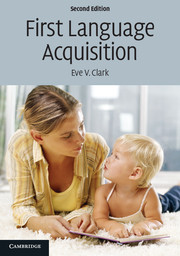Book contents
- Frontmatter
- Contents
- List of tables, boxes, and figures
- Acknowledgements
- 1 Acquiring language: Issues and questions
- Part I Getting started
- Part II Constructions and meanings
- 7 First combinations, first constructions
- 8 Modulating word meanings
- 9 Adding complexity within clauses
- 10 Combining clauses: More complex constructions
- 11 Constructing words
- Part III Using language
- Part IV Process in acquisition
- Glossary
- References
- Name index
- Subject index
7 - First combinations, first constructions
from Part II - Constructions and meanings
- Frontmatter
- Contents
- List of tables, boxes, and figures
- Acknowledgements
- 1 Acquiring language: Issues and questions
- Part I Getting started
- Part II Constructions and meanings
- 7 First combinations, first constructions
- 8 Modulating word meanings
- 9 Adding complexity within clauses
- 10 Combining clauses: More complex constructions
- 11 Constructing words
- Part III Using language
- Part IV Process in acquisition
- Glossary
- References
- Name index
- Subject index
Summary
As children add to their first words, they add specificity and detail to how they express what they want and what they are interested in. This all entails including more information, and hence more complexity, in each utterance, as in the move from More block to I need another block or They've got all the blocks. This in turn requires the learning of structure: structure in the form of contrasting inflections added to words and in the form of constructions reflected in the combinations of words. To do all this, children have to start learning to think for speaking in their first language (Slobin 1996). That is, they must start to use the conventional constructions for expressing particular meanings.
The focus of this chapter is on the move from single-word utterances to longer utterances, the emergence of multiword combinations, and the meanings children use these combinations to express. In doing this, do children begin from formulaic forms that they then analyze into the component parts, much as they try whole words and only later extract the segmental details (Chapter 5)? Or do they build up utterances one element at a time, with each word or affix that they add? That is, what do longer utterances tell us about emerging structures and the uses children make of them at this stage in speaking?
- Type
- Chapter
- Information
- First Language Acquisition , pp. 151 - 175Publisher: Cambridge University PressPrint publication year: 2009



